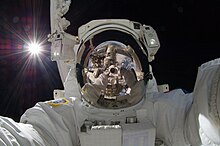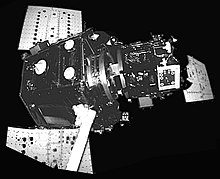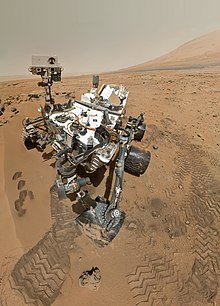
Space exploration is the use of astronomy and space technology to explore outer space. While the exploration of space is currently carried out mainly by astronomers with telescopes, its physical exploration is conducted both by uncrewed robotic space probes and human spaceflight. Space exploration, like its classical form astronomy, is one of the main sources for space science.

Mars 3 was a robotic space probe of the Soviet Mars program, launched May 28, 1971, nine days after its twin spacecraft Mars 2. The probes were identical robotic spacecraft launched by Proton-K rockets with a Blok D upper stage, each consisting of an orbiter and an attached lander. After the Mars 2 lander crashed on the Martian surface, the Mars 3 lander became the first spacecraft to attain a soft landing on Mars, on December 2, 1971. It failed 110 seconds after landing, having transmitted only a gray image with no details. The Mars 2 orbiter and Mars 3 orbiter continued to circle Mars and transmit images back to Earth for another eight months.

The Mars Reconnaissance Orbiter (MRO) is a spacecraft designed to search for the existence of water on Mars and provide support for missions to Mars, as part of NASA's Mars Exploration Program. It was launched from Cape Canaveral on August 12, 2005, at 11:43 UTC and reached Mars on March 10, 2006, at 21:24 UTC. In November 2006, after six months of aerobraking, it entered its final science orbit and began its primary science phase.

Mars Science Laboratory (MSL) is a robotic space probe mission to Mars launched by NASA on November 26, 2011, which successfully landed Curiosity, a Mars rover, in Gale Crater on August 6, 2012. The overall objectives include investigating Mars' habitability, studying its climate and geology, and collecting data for a human mission to Mars. The rover carries a variety of scientific instruments designed by an international team.

Akihiko Hoshide is a Japanese engineer, JAXA astronaut, and former commander of the International Space Station. On August 30, 2012, Hoshide became the third Japanese astronaut to walk in space.

A Mars landing is a landing of a spacecraft on the surface of Mars. Of multiple attempted Mars landings by robotic, uncrewed spacecraft, ten have had successful soft landings. There have also been studies for a possible human mission to Mars including a landing, but none have been attempted. Soviet Union’s Mars 3, which landed in 1971, was the first successful Mars landing. As of 2023, the Soviet Union, United States and China have conducted Mars landings successfully.

The National Aeronautics and Space Administration is an independent agency of the U.S. federal government responsible for the civil space program, aeronautics research, and space research. Established in 1958, it succeeded the National Advisory Committee for Aeronautics (NACA) to give the U.S. space development effort a distinctly civilian orientation, emphasizing peaceful applications in space science. It has since led most American space exploration, including Project Mercury, Project Gemini, the 1968–1972 Apollo Moon landing missions, the Skylab space station, and the Space Shuttle. It currently supports the International Space Station and oversees the development of the Orion spacecraft and the Space Launch System for the crewed lunar Artemis program, the Commercial Crew spacecraft, and the planned Lunar Gateway space station.
NASA has hosted many events for its social media enthusiasts called NASA Socials beginning in 2009. These events are targeted at the social media followers of NASA through platforms such as Twitter, Facebook, Google Plus, Instagram, YouTube and more. They provide guests with VIP access to NASA facilities and speakers with the goal of leveraging participants' social networks to further the outreach requirements of NASA as laid out in the National Aeronautics and Space Act. NASA re-branded these events as "Socials" in March 2012 as it expanded participation to services beyond just Twitter.

Curiosity is a car-sized Mars rover exploring Gale crater and Mount Sharp on Mars as part of NASA's Mars Science Laboratory (MSL) mission. Curiosity was launched from Cape Canaveral (CCAFS) on November 26, 2011, at 15:02:00 UTC and landed on Aeolis Palus inside Gale crater on Mars on August 6, 2012, 05:17:57 UTC. The Bradbury Landing site was less than 2.4 km (1.5 mi) from the center of the rover's touchdown target after a 560 million km (350 million mi) journey.

Mars Hand Lens Imager (MAHLI) is one of seventeen cameras on the Curiosity rover on the Mars Science Laboratory mission.

Navcam, short for navigational camera, is a type of camera found on certain robotic rovers or spacecraft used for navigation without interfering with scientific instruments. Navcams typically take wide angle photographs that are used to plan the next moves of the vehicle or object tracking.

A selfie is a self-portrait photograph or a short video, typically taken with an electronic camera or smartphone. The camera would be usually held at arm's length or supported by a selfie stick instead of being controlled with a self-timer or remote. The concept of shooting oneself while viewing their own image in the camera's LCD monitor is also known as self-recording.

The Day the Earth Smiled is a composite photograph taken by the NASA spacecraft Cassini on July 19, 2013. During an eclipse of the Sun, the spacecraft turned to image Saturn and most of its visible ring system, as well as Earth and the Moon as distant pale dots. The spacecraft had twice taken similar photographs in its previous nine years in orbit around the planet. The name also refers to the activities associated with the event, as well as to the photographic mosaic created from it.
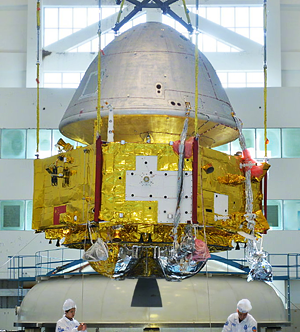
Tianwen-1 Chinese: 天问一号 is an interplanetary mission by the China National Space Administration (CNSA) which sent a robotic spacecraft to Mars, consisting of 6 spacecraft: an orbiter, two deployable cameras, lander, remote camera, and the Zhurong rover. The spacecraft, with a total mass of nearly five tons, is one of the heaviest probes launched to Mars and carries 14 scientific instruments. It is the first in a series of planned missions undertaken by CNSA as part of its Planetary Exploration of China program.
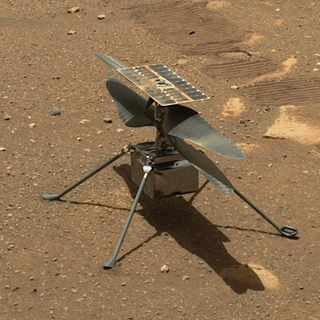
This article documents notable spaceflight events during the year 2021. 2021 saw several spaceflight related records being set worldwide. This includes both the most orbital launch attempts and most successful orbital launches in a year. In addition, 2021 saw records set in the number of humans in orbit at one time and the most humans in space at one time.

Martian Moons eXploration (MMX) is a robotic space probe set for launch in 2026 to bring back the first samples from Mars' largest moon Phobos. Developed by the Japan Aerospace Exploration Agency (JAXA) and announced on 9 June 2015, MMX will land and collect samples from Phobos once or twice, along with conducting Deimos flyby observations and monitoring Mars's climate.

Perseverance, nicknamed Percy, is a car-sized Mars rover designed to explore the Jezero crater on Mars as part of NASA's Mars 2020 mission. It was manufactured by the Jet Propulsion Laboratory and launched on July 30, 2020, at 11:50 UTC. Confirmation that the rover successfully landed on Mars was received on February 18, 2021, at 20:55 UTC. As of 3 February 2024, Perseverance has been active on Mars for 1051 sols since its landing. Following the rover's arrival, NASA named the landing site Octavia E. Butler Landing.

